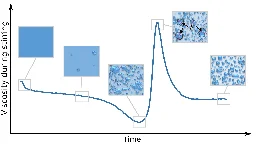Fondant: Where baking and thermodynamics mix
Fondant: Where baking and thermodynamics mix
phys.org Fondant: Where baking and thermodynamics mix
With their unique appearance, texture, and mouthfeel, fondants have intrigued bakers and physicists for years. They present an appetizing enigma in the world of confectionery, an intriguing combination of sugar, water, and heat that, when manipulated correctly, yields a delectably creamy product.

This is about a recent study looking at the rheology of fondant. Essentially, fondant is created from a supersaturated solution of sucrose that is agitated (kneaded). This causes the fondant to experience a sequence of events:
- First, the agitation induces crystal nucleation and growth. In the early stages of crystal formation, the surrounding solution is depleted of sucrose, reducing the bulk viscosity.
- However, as the crystals grow in size, they are large enough to push against one another in hard sphere-like interactions. This causes a sharp increase in viscosity at this critical crystal size.
- As agitation continues, sucrose crystals fracture and the system reaches an equilibrium crystal size distribution, causing the viscosity to decrease from its peak. This is the final state of a smooth, pliable fondant.
There is a doi provided by the article, but as of my posting this, the doi hasn't been activated yet.
0
comments